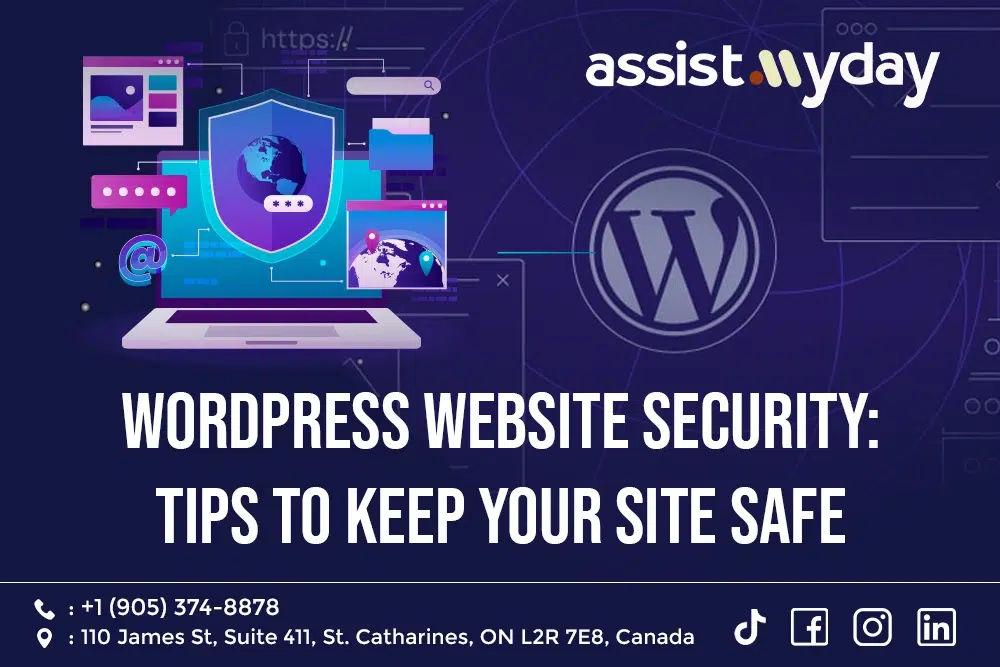WordPress Website Security: Tips to Keep Your Site Safe
In today’s digital landscape, website security is critical to protecting your business, customer data, and reputation. WordPress powers over 43% of websites worldwide, making it a prime target for cyber threats. Ensuring your WordPress site is secure requires proactive measures to minimize risks and maintain user trust.
At Assist My Day, we understand the importance of securing your WordPress website. Below are comprehensive security tips to safeguard your site against malicious attacks and vulnerabilities.
1. Keep Everything Updated
Outdated software is a common entry point for attackers. WordPress, themes, and plugins frequently release updates that patch security issues and improve performance. Neglecting updates leaves your site exposed to threats.
Best Practices:
- Enable automatic updates for WordPress core files to ensure the latest security patches are applied promptly.
- Regularly update plugins and themes to reduce vulnerabilities.
- Remove unused or inactive plugins and themes to eliminate potential security risks.
By keeping your WordPress website updated, you significantly reduce the chances of exploitation and improve site stability.
2. Strengthen Login Security
Brute force attacks target weak usernames and passwords, attempting to gain unauthorized access. Strengthening your login credentials is an effective way to block such attacks.
Effective Solutions:
- Create strong passwords using a mix of uppercase and lowercase letters, numbers, and special characters.
- Enable Two-Factor Authentication (2FA) for additional login security. Tools like Google Authenticator and Authy provide effective solutions.
- Use plugins such as Limit Login Attempts Reloaded to restrict failed login attempts.
- Add CAPTCHA to login pages to prevent automated bot attacks.
Enforcing strong login security measures minimizes the risk of unauthorized access.
3. Install a Security Plugin
Security plugins offer an all-in-one solution for protecting your website, featuring malware scanning, firewalls, and real-time alerts to detect and prevent threats.
Recommended Plugins:
- Wordfence Security: Offers firewall protection, malware scanning, and live traffic monitoring.
- Sucuri Security: Provides blacklist monitoring, file integrity checks, and security audits.
- iThemes Security: Features two-factor authentication, brute force protection, and real-time notifications.
Installing a security plugin ensures your website benefits from active protection against known vulnerabilities.
4. Choose a Secure Hosting Provider
A secure hosting environment is crucial in protecting your WordPress site from server-level attacks. Choosing a trusted hosting provider enhances your website’s resilience.
Key Features to Look For:
- Hosting providers with built-in firewalls and malware detection.
- Free SSL certificates to encrypt data transfers.
- Daily or weekly backups for quick restoration in case of attacks or failures.
SiteGround, WP Engine, and Kinsta are highly recommended providers offering managed WordPress hosting with top-tier security features.
5. Enable SSL and Use HTTPS
Secure Socket Layer (SSL) encrypts data transmitted between your website and its visitors. Enabling HTTPS secures user data and boosts search engine rankings.
Steps to Implement SSL:
- Obtain a free SSL certificate from your hosting provider or Let’s Encrypt.
- Update your WordPress settings to enable HTTPS across all pages.
- Use plugins like Really Simple SSL to simplify the transition.
SSL encryption enhances user trust and strengthens website security.
6. Backup Your Website Regularly
Despite implementing preventive measures, unforeseen events like data loss or cyberattacks can still occur. Regular backups ensure you can restore your site quickly with minimal downtime.
Recommended Backup Solutions:
- UpdraftPlus: Automates backups to cloud storage platforms like Google Drive or Dropbox.
- VaultPress (Jetpack Backup): Offers real-time backups and one-click restoration.
- BackupBuddy: Provides scheduled backups and site migration tools.
Store backups in multiple locations to minimize risks of data loss.
7. Manage User Roles and Permissions
Improperly assigned user roles can lead to accidental changes or malicious activities. Assigning appropriate roles and permissions is key to preventing security risks.
Tips for User Management:
- Assign roles such as Administrator, Editor, and Contributor according to specific responsibilities.
- Remove inactive or unauthorized user accounts regularly.
- Monitor user activity with plugins like WP Activity Log to track suspicious actions.
Limiting unnecessary access reduces internal security risks.
8. Use a Web Application Firewall (WAF)
A Web Application Firewall (WAF) acts as a protective barrier between your website and potential threats. It filters malicious traffic, blocking harmful requests before they reach your site.
Recommended WAF Tools:
- Cloudflare: Offers DDoS protection, improved website performance, and content delivery optimization.
- Sucuri Firewall: Provides advanced security features and a content delivery network (CDN) for faster page speeds.
Implementing a WAF strengthens your website’s ability to fend off attacks.
9. Monitor and Scan Your Website
Continuous monitoring helps detect security threats early, ensuring your site remains protected.
Recommended Tools:
- MalCare or SiteLock for automated malware detection and removal.
- Google Search Console for identifying site vulnerabilities and performance issues.
- Regularly review server logs to detect suspicious activity or unauthorized access attempts.
Regular scanning and monitoring enable you to address potential threats before they escalate.
10. Disable File Editing in WordPress Dashboard
WordPress allows administrators to edit theme and plugin files directly from the dashboard, which presents a security risk if compromised. Disabling this feature minimizes the risk of attackers injecting malicious code into your website.
Conclusion
Securing your WordPress website is an ongoing process that requires vigilance and proactive steps. By implementing these strategies, you can protect your website, business, and customers from cyber threats.
At Assist My Day, we specialize in comprehensive WordPress security solutions, from SSL setup to routine maintenance and real-time monitoring. Our experts are dedicated to safeguarding your site so you can focus on growing your business.
Contact us today to learn more about how we can help secure your WordPress website!

